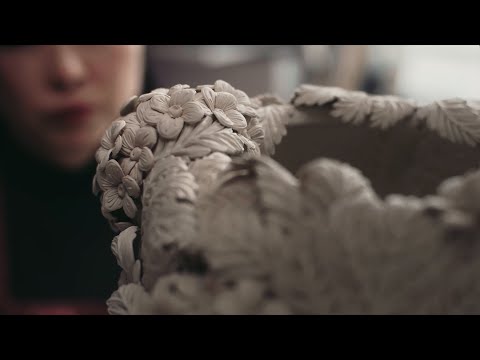Ceramics Artist: Job Description & Salary
Ceramics Artist Job Description: A ceramics artist is a professional who creates artistic pieces using clay and other materials. They use various techniques such as hand-building, wheel-throwing, and glazing to shape and decorate their ceramics. Ceramics artists may specialize in different types of ceramics, such as pottery, sculpture, or decorative items. They typically work in art studios or their own workshops, where they have access to kilns and other necessary tools.
Ceramics artists are responsible for designing and creating unique and visually appealing ceramic pieces. They often collaborate with clients or art directors to understand their requirements and create customized pieces. They also experiment with different clay types, glazes, and firing techniques to achieve desired results. Additionally, ceramics artists may exhibit their work in galleries, participate in art fairs, or sell their pieces online.
Ceramics Artist Salary: The salary of a ceramics artist can vary depending on factors such as experience, skill level, reputation, and location. According to the Bureau of Labor Statistics, the median annual wage for fine artists, including ceramics artists, was $48,960 in May 2020. However, it is important to note that this figure includes all types of fine artists and not just ceramics artists.
Experienced and well-established ceramics artists may earn significantly higher salaries, especially if they have a strong client base or sell their work at high-end galleries. However, it is also common for ceramics artists to have irregular income, as their earnings may depend on the sale of their artwork.
Overall, becoming a ceramics artist can be a fulfilling career choice for those with a passion for art and creativity, although it may require dedication, skill development, and perseverance to achieve financial success.

Ceramics Artist Job Description Template
Ceramics Artist Job Description
A ceramics artist is a skilled professional who works with clay to create various artistic pieces. They use their creativity, artistic skills, and technical knowledge to design and produce unique pottery, sculptures, and other ceramic objects. Ceramics artists typically work in a studio environment, either independently or as part of a team.
The job duties of a ceramics artist may include:
1. Designing and Planning: Ceramics artists start by conceptualizing and sketching their ideas for new pieces. They plan the materials, techniques, and processes required to bring their designs to life.
2. Creating Ceramic Art: Using various techniques such as hand-building, wheel throwing, and slip casting, ceramics artists shape and mold clay into desired forms. They apply glazes, paints, and other decorative elements to enhance the appearance of their artwork.
3. Firing and Kiln Operations: Ceramics artists are responsible for loading and operating kilns to fire their creations. They must understand the temperature and timing requirements for different types of clay and glazes to achieve desired results.
4. Finishing and Refining: After firing, ceramics artists carefully inspect their artwork for any imperfections or flaws. They may use sanding, polishing, or other techniques to refine the surface texture and ensure the quality of the finished pieces.
5. Exhibition and Promotion: Ceramics artists often participate in art exhibitions, craft shows, and galleries to showcase and sell their work. They may also use social media and other marketing platforms to promote their artwork and attract potential buyers.
In summary, a ceramics artist is responsible for conceptualizing, designing, and creating ceramic artwork using various techniques. They must possess a strong artistic vision, manual dexterity, and knowledge of ceramic materials and processes.
Ceramics Artist Responsibilities
- Creating original ceramic artwork
- Designing and planning ceramic pieces
- Preparing clay and other materials for use
- Shaping and molding clay using various techniques
- Glazing and firing ceramic pieces
- Decorating and embellishing ceramic artwork
- Repairing and restoring damaged ceramics
- Collaborating with other artists and clients on commissioned projects
- Researching and experimenting with new techniques and materials
- Maintaining a clean and organized studio space
- Marketing and promoting artwork through exhibitions, galleries, and online platforms
- Managing inventory and sales of ceramic pieces
- Continuing education and professional development in the field of ceramics
Ceramics Artist Requirements
- A strong passion for ceramics and the desire to create unique and innovative artworks.
- Artistic skills and creativity to design and shape clay into various forms and structures.
- Knowledge of different ceramic techniques such as wheel-throwing, hand-building, and glazing.
- Understanding of various types of clay and their properties.
- Ability to work with different tools and equipment used in ceramics, such as kilns and pottery wheels.
- Attention to detail and patience to meticulously work on intricate ceramic designs.
- Ability to follow safety protocols while working with hazardous materials and operating equipment.
- Good physical stamina and dexterity to handle heavy clay objects and perform repetitive tasks.
- Knowledge of art history and understanding of different art movements to draw inspiration for ceramic designs.
- Strong communication and interpersonal skills to collaborate with clients, art galleries, and other artists.
- Business acumen to market and sell ceramic artworks, manage finances, and maintain a professional studio.
How Much Does A Ceramics Artist Make?
Ceramics Artist Salary
| Experience Level | Salary Range |
|---|---|
| Entry Level | $30,000 – $40,000 per year |
| Mid-Career | $40,000 – $60,000 per year |
| Experienced | $60,000 – $80,000 per year |
| Senior Level | $80,000+ per year |
A ceramics artist’s salary can vary depending on their experience level. Entry-level artists can expect to earn between $30,000 and $40,000 per year. As they gain more experience and develop their skills, the salary range increases. Mid-career ceramics artists can earn between $40,000 and $60,000 per year, while experienced artists can make between $60,000 and $80,000 per year. Those at the senior level, who have extensive experience and a strong reputation in the field, can earn $80,000 or more per year. It’s important to note that these figures are approximate and can vary based on factors such as location, reputation, and demand for the artist’s work.
Ceramics Artist Salaries by Country
Top Paying Countries for Ceramics Artist
| Country | Average Salary |
|---|---|
| United States | $50,000 |
| Switzerland | $48,000 |
| Australia | $45,000 |
| Canada | $42,000 |
| Germany | $40,000 |
A ceramics artist’s salary can greatly vary depending on the country they work in. According to data, the top paying countries for ceramics artists are the United States, Switzerland, Australia, Canada, and Germany. In the United States, the average salary for a ceramics artist is $50,000 per year, while in Switzerland it is $48,000. Australia offers an average salary of $45,000, followed by Canada with $42,000, and Germany with $40,000. These countries not only offer competitive salaries but also provide various opportunities for ceramics artists to showcase their talent and skills.
A video on the topic Ceramics Artist
Interview Questions for Ceramics Artist
1. How did you become interested in ceramics?
I became interested in ceramics during my high school art class. I was drawn to the tactile nature of the medium and the endless possibilities for creativity.
2. Can you tell us about your artistic background?
I have always been interested in art and pursued it throughout my education. I have a Bachelor’s degree in Fine Arts with a focus on ceramics. I have also attended various ceramic workshops and exhibitions to further develop my skills.
3. What inspires your ceramic creations?
I draw inspiration from nature, particularly organic forms and textures. I also find inspiration in different cultures and historical periods, incorporating elements from them into my work.
4. Can you describe your artistic process?
My artistic process begins with sketching out ideas and experimenting with different forms and techniques. Once I have a clear vision, I start working with clay, sculpting and shaping it into the desired form. After the initial firing, I apply glazes and pigments to add color and texture. The final step is firing the piece again to achieve the desired finish.
5. What challenges do you face as a ceramics artist?
One of the main challenges I face is the technical aspect of ceramics, such as understanding clay properties and kiln firing processes. It can also be challenging to balance creativity with functionality, ensuring that my pieces are both aesthetically pleasing and practical to use.
6. What is your favorite part about working with ceramics?
My favorite part about working with ceramics is the hands-on nature of the medium. I enjoy the process of molding and shaping the clay with my hands, and the satisfaction of seeing a finished piece that I have brought to life.
7. Can you tell us about a memorable moment in your ceramics career?
A memorable moment in my ceramics career was when one of my pieces was selected for a prestigious art exhibition. It was a validation of my skills and hard work, and it gave me the confidence to continue pursuing ceramics as a career.
8. How do you continue to develop your skills as a ceramics artist?
I continue to develop my skills by attending workshops and classes to learn new techniques and explore different styles. I also actively seek feedback from other artists and participate in exhibitions to showcase my work and receive constructive criticism.
9. Do you have any advice for aspiring ceramics artists?
My advice for aspiring ceramics artists is to practice regularly and not be afraid to make mistakes. Experiment with different techniques and materials, and always be open to learning and growing as an artist. Also, don’t be discouraged by setbacks, as they are an essential part of the creative process.
10. What do you hope to achieve as a ceramics artist in the future?
In the future, I hope to continue pushing the boundaries of ceramics and exploring new possibilities within the medium. I aspire to have my work showcased in renowned galleries and museums, and to inspire others through my art.
The Best Universities For The Ceramics Artist Profession.
- Royal College of Art (RCA)
- University of the Arts London (UAL)
- Alfred University
- California College of the Arts
- New York State College of Ceramics at Alfred University
- Rhode Island School of Design (RISD)
- University of Washington
- Cranbrook Academy of Art
- Pratt Institute
- Ohio State University






